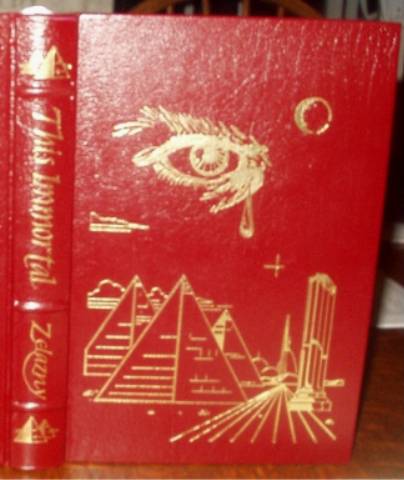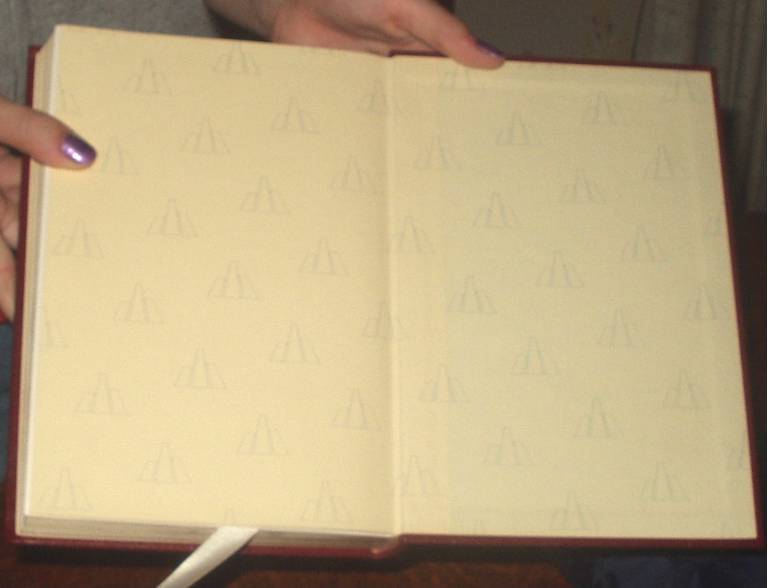

What You Bring To the Reading Room
Last time out, the trivia question was: Stanley G Weinbaum was known for his
inventiveness and, at the time, solid science in his fiction. Today's SF, of
course, runs the gamut between what is really fantasy and hard science
fiction typified by such writers as Asimov, Brin, and Bedford (to stick to
the beginning of the alphabet). One hard SF writer in particular, who's been
at it for nearly forty years, has built an extensive universe and populated
it with entirely believable critters and peoples. Who is the creator of the
following species: Pak, Trinocs, and Outsiders (which has nothing to
do with HP Lovecraft, bear in mind)?
And the answer is, Larry Niven. This is something of a gimme for true SF
fans, Iíd think. Larry Niven has been a stalwart figure in the SF field
since he first appeared in Galaxy and If
magazines. Early in his career, he decided that some of the hard background
work he did for his SF stories shouldnít go to waste and began to build a
universe of his own, prosaically called of course, Known Space. It is
indeed a rich and detailed universe and heís still writing stories in
itóincluding the newly released Ringworld Children [Footnote
1]. I left out the Kzinti from the lists, as well as puppeteers since I thought they made it too absurdly easy. The species mentioned above are as
follows:
Pak: The progenitors of humanity in ALL itís form, the Pak
come from a world very much closer to the center of the galaxy and exist in
three stages, infants/children, breeders, & protectors. The protectors are
super-intelligent modifications of the original somewhat human form,
dedicated by evolution and a weird virus to the protection of their own
progeny. They ended up building Ringworld.
Trinocs: A young race of beings, very touchy about a lot of
things and not greatly detailed in the Niven books. But they see by radar
and one at least, is a great artist. See the Beowulf Schaefer stories.
Outsiders: A very strange race of critters that are
bases on a completely different biochemistry than any of the other species
in Nivenís Known Space. They developed in an extremely cold
environment where liquid helium is cold enough to exhibit strange
properties. They also are the original inventors of the hyperdrive, which
they sold to humanity for a huge sum of money. They have a weird fixation
with a strange space-going plant that migrates from the galactic core to the
extreme ends of the galactic arms, and back again. No one knows why and the
fee they would charge to explain is more than the worth of Known
Space.
If youíre not a Niven fan, you should be. Rich, rich imagination and solid
writing. No more needs to be said.
* * * *
This time out is going to be different, again. Possibly even weird. So, sit
back and see if you can follow a particularly weird thread that all starts
with Roger Zelazny.
Iíve been a fan of Roger Zelazny for a long time, though I find I prefer his
earlier works to his later ones. In point of fact, my favorite Zelazny title
is This Immortal (aka And Call Me Conrad), which
won a Hugo. It originally was published in Fantasy & Science
Fiction and then slightly expanded and published by Ace. There was
no early hardback version.
Back in the very early 80ís, I chanced to stumble across the Greg Press
series of books, a very nice, understated (and somewhat underappreciated)
series that didnít have dust jackets and was uniformly bound in a sharp
looking dark gray with silver lettering. I ended up buying some L. Ron
Hubbard (Final Blackout) as well as their printing of
This Immortal. It was nice, finally, to have a hardback
version of it.
I was short of money (as all young married people seem to be, barring of
course preppies from oil rich parents in Texas), and couldnít afford many
books for the rest of the 80ís and consequently missed out on the beginning
of a great series of books by Easton Press. Easton Press is kind of a classy
book club company that specializes in not specializing. They do the
classics, they do contemporary, they do just about everything one can think
of, but all of the titles are well done. Think of them as the top of the
book club chain and you wonít be far off the mark.
They brought a new series in the 1980ís called The Science Fiction
Classics that ranged from early classics to newer ones to some that
were, when first published by them, new indeed. They attempted (and
accomplished to my mind) to be representative of the entire Science Fiction
field, from the beginning to the present. They didnít concentrate on a
single author or style (New Wave vs. Hard SF vs. whatever). Iíve wondered
how they decide which book to include and which book to omit, but from
looking at the list, I canít even begin to guess.
I just picked up a copy of Zelaznyís This Immortal and itís a
beautiful example of the art of book binding and printing. No dust jacket,
however. None of the Easton Press titles have a dust jacket because they are
showcasing the art of bookbinding.

This Immortal is bound in a deep maroon leather with gold
embossing on the face, back and spine. For the Zelazny title, they had some
Egyptian theme designs on the face and back (part of the novel takes place
in Egypt), as well as interior ink illustrations. The paper is beautiful.
The book even sports an attached ribbon for marking oneís place, much like
one finds in truly classic books or the Bible. The trimmed pages are
tipped with gold. Price was fairly cheap, considering: $45.00 (and yes, it
was a used book, but used by a collector. Itís virtually spotless).

Now, hereís the crux of this column. Is such a book collectable?
Remember, this particular book is really nothing more than the output of a
very expense book club. Very classy, perhaps, but still tarred with the same
brush as The Franklin Mint issues of coins. Are they on a par with
books Iíve mentioned in past columns that really are published strictly for
the collectorís market? Perhaps.
I ran into another book that falls roughly into what Iíve more or less
termed collectorís market books (Wandering Star in England and much of the
Don Grant books, these days), by Mike Resnick, called
Adventure and exchanged a couple of emails with Mike about the
book. There are two versions of the book that were published. The first has
a faux leather binding and appears to be a nicely bound and printed book
from the images Iíve seen. But the second version only had a grand total of
twenty-six (yes, 26) copies printed and bound, each assigned one letter of
the alphabet and inscribed by Mike. I asked him about the books and for his
thoughts on book collecting.
Mikeís a professional writer, first, last and always [Footnote 2]. His
response was more or less that he didnít. Think about book collecting. For
him, itís kind of a null topic. He merely wants to continue writing fine
fiction (non-fiction as well, for that matter) and stretching himself as a
writer. Book collecting? Why would he want to spend time thinking about
that?
I honestly couldnít give him a legitimate reason since there probably is no
one solid reason why book collecting can be called a good thing.
Except to note this: The great libraries of the world were more or less
assembled with the idea of collecting books [Footnote 3]. There
is a purpose to it all: Preserving the knowledge, thoughts, dreams and
experiences of the human race. Along the way, books themselves occasionally
became works of art and the contents of them mattered a bit less -- but I
defy anyone to point to a book that is both a work of art and filled with
blank, empty pages. Sure, people buy blank books for journals and what-not,
but theyíre not what Iím talking about. Books that are beautiful and exhibit
the best of the binding art all have something inside of them, at the core,
that invited the passion of someone else. Thatís why people become
rabid Robert E. Howard collectors, or collectors of H. P. Lovecraft or L.
Frank Baum or any legion of other writers. Why, for example, I have copies
of books by Mike Resnick, and they sit side by side with other books that
individually and collectively, mean a great deal to me.
So, the question is thus answered, albeit by a curved and idiosyncratic line
of reasoning. Yes, the Easton Press copy of This Immortal
is a collectable book. Because of what I, personally, bring to the
book. The book is more than the contents. It is more than the art displayed
in the binding. Itís what I, personally, bring to the book and take away
with me when I put it back on the shelf. Itís the effect of the words Iíve
read, the images Iíve imagined and the stories Iíve lived in the reading of
the book. You bet itís collectable.
I warned you this was going to be a weird column, didnít I?
Trivia Question:
The years 1965 and 1966 were huge for Zelazny, when it came to
awards.
Hereís a quick list of the nominations and award Zelazny earned during 1965
and 1966.
Hugo Nomination: ďThe Doors of His Face, the Lamps of His MouthĒ, best
novelette (1965).
Hugo Award: This Immortal (1966).
Nebula Award: ďHe Who ShapesĒ, novella (1965), ďThe Doors of his Face, the
Lamps of His MouthĒ, novelette (1965),
One other writer was just breaking into the field at that time and went up
against Zelazny for a number of the awards above. Who was that writer and
what awards did he win? The answer of course, will be next time.
* * * *
Footnote 1: Just out recently. Itís published by Tor, ISBN
0-765-30167-9, $24.95, 284 pp. There is a review in this issue of DMR.
Return
Footnote 2: Which is why he is so patient with email from weird people he
doesnít know or at least, doesnít know very well. He strikes me as having a
huge store of patience . . . .
Return
Footnote 3: All right, manuscripts to be more accurate about the great
libraries of antiquity.
Return
Return to the Table of Contents
Reviews Updated for 2009! | Issues 2001-2004 | Links | About DMR | Home




